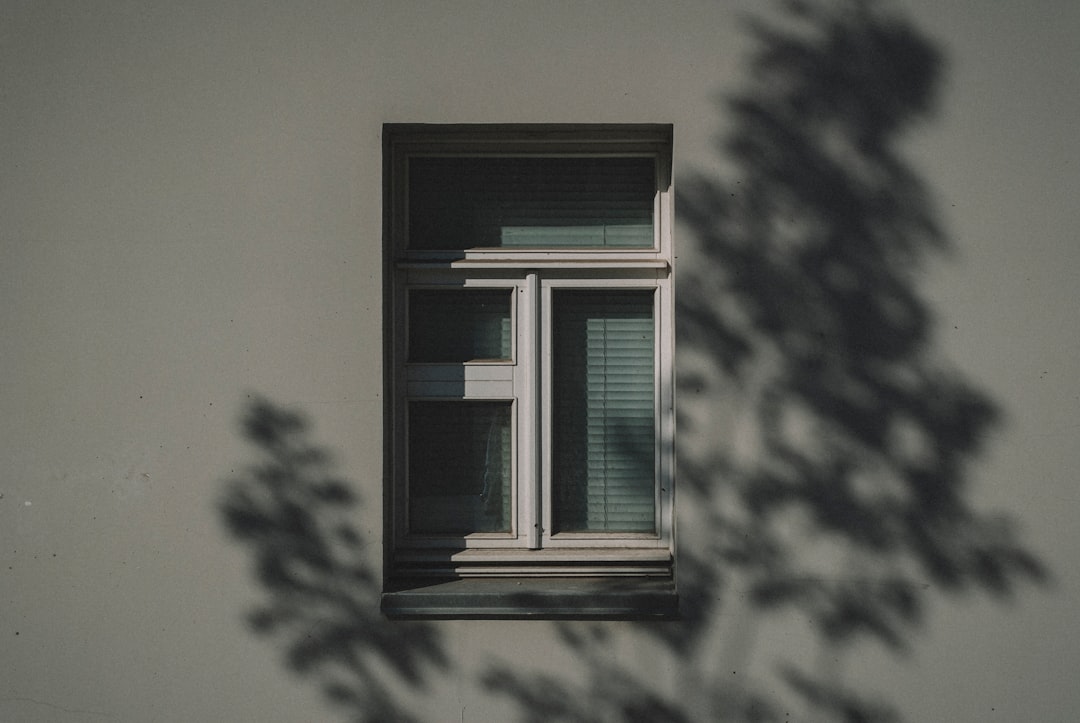Understanding the Investment in New Windows
The cost to replace a window ranges from $300 to $2,500 per window, with most homeowners paying between $500 and $1,000 per window for materials and labor.
Quick Cost Breakdown:
- Low-cost projects: $200-$600 per window (basic vinyl, standard sizes)
- Medium-cost projects: $750-$2,500 per window (quality materials, energy-efficient glass)
- High-cost projects: $3,000-$5,000+ per window (premium materials, custom sizes)
- Whole house replacement: $8,000-$22,500 for 10-15 windows
The national average for window replacement is around $650 per window, but your actual costs depend on window type, frame material, glass package, and installation complexity.
Outdated windows lead to high energy bills, drafts, and noise. For many Chicago homeowners, this is a familiar problem. While the upfront investment might seem steep, new windows typically provide a 75-85% return on investment and can save up to $583 per year on energy bills.
I’m Voytek Glab, owner of Perfect Windows & Siding. For over 20 years, I’ve helped Chicago-area homeowners understand the cost to replace a window and make smart investments. My experience with thousands of installations provides unique insight into what drives pricing and value.
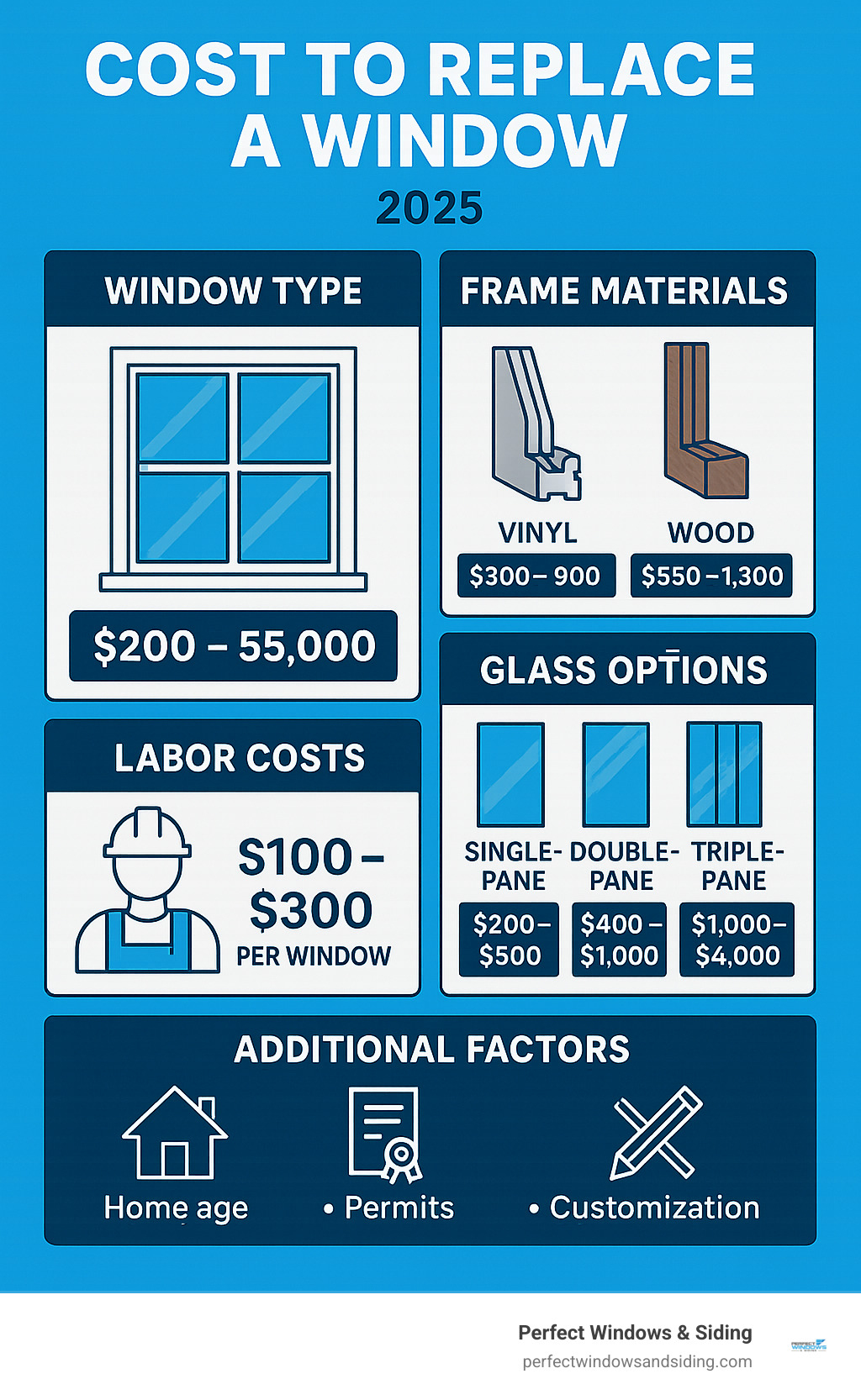
Breaking Down the Cost to Replace a Window
Understanding the cost to replace a window is simpler when you break it down. The final price depends on each component you choose. The main factors that determine your cost are the window type, frame material, glass package, labor, and any customization.
For example, a simple double-hung window costs less than a large bay window. A budget-friendly vinyl frame has a different price point than premium wood. The glass package is key for energy efficiency, with options ranging from standard double-pane to high-performance triple-pane with Low-E coatings.
As a local Chicago company, we explain how each choice affects your budget, ensuring you get honest guidance without pressure. If you want to dive deeper, check out more info about our window replacement services. To learn how to cut energy bills, our tips for buying energy efficient windows can help you make smart choices.
How Frame Materials Impact the Cost to Replace a Window
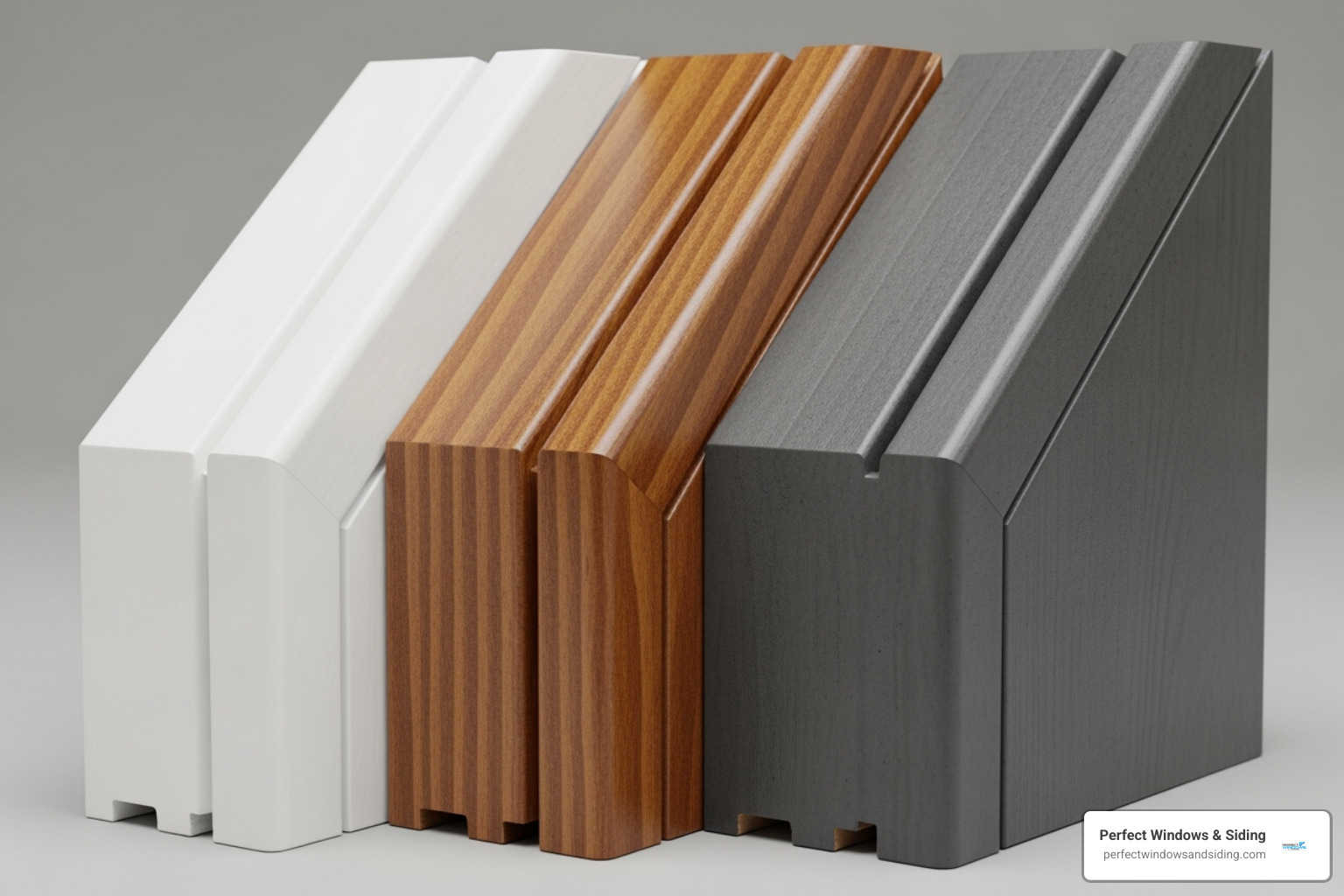
Your choice of frame material is one of the biggest factors in the cost to replace a window.
-
Vinyl windows ($100 to $900 per window) are the most popular choice. They are budget-friendly, energy-efficient, and low-maintenance, lasting up to 30 years. For a small upgrade, insulated vinyl frames offer even better performance. Our vinyl replacement windows in Chicago are ideal for local weather.
-
Wood windows ($400 to $1,300 per window) offer a classic, beautiful look and are natural insulators. However, they require regular maintenance like painting or staining to prevent rot and can last for decades with proper care.
-
Composite windows ($300 to $1,200 per window) blend materials to offer the look of wood with the durability of vinyl. They are a strong, low-maintenance middle ground.
-
Fiberglass windows ($400 to $1,500 per window) are a premium option. They are incredibly strong, won’t warp or crack, and can last 50 years, making them perfect for large window openings.
-
Aluminum windows ($300 to $800) are strong and allow for slim frames, but they are poor insulators. I typically don’t recommend them for Chicago’s climate unless required for a specific design.
Window Styles and Their Price Points
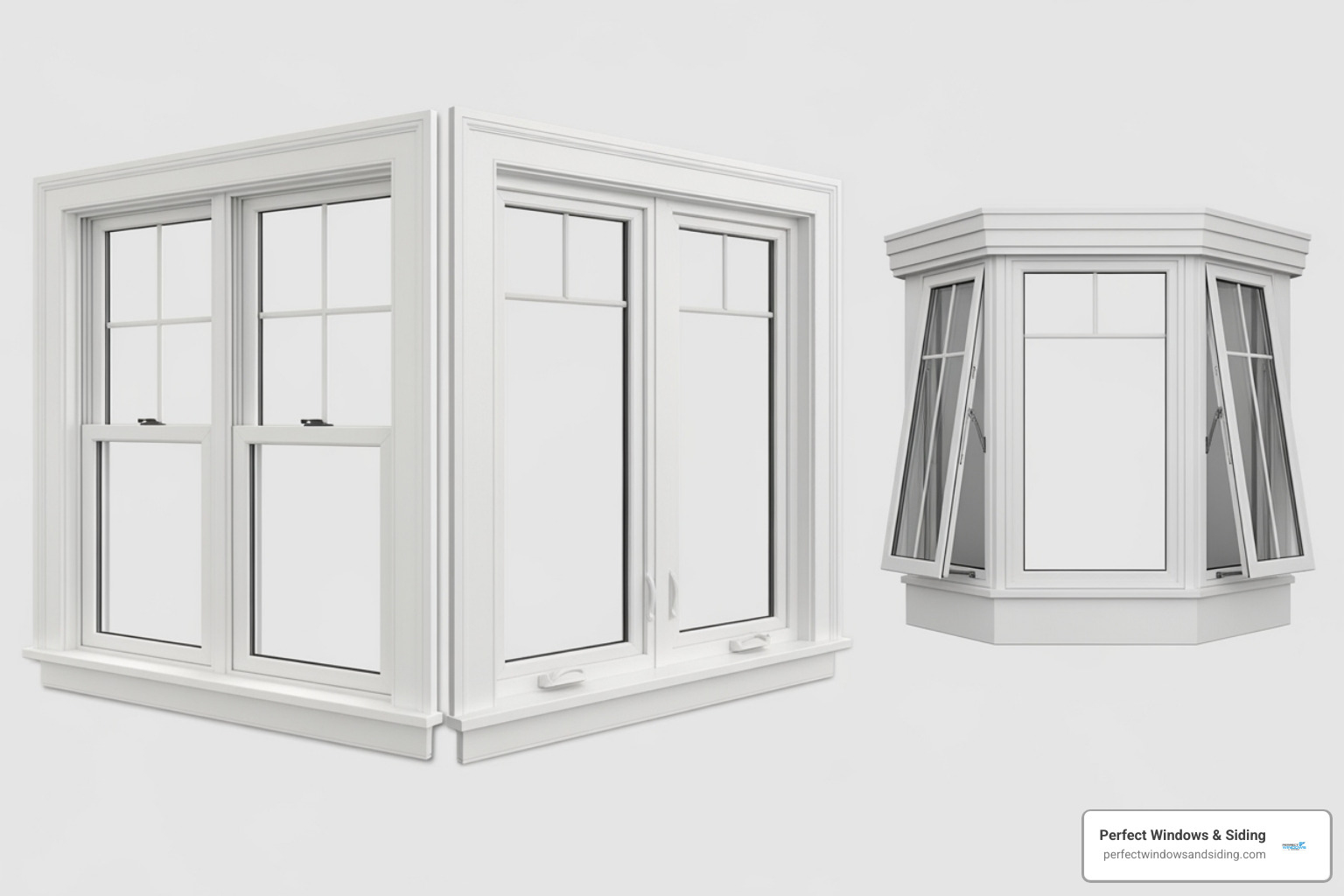
Window style also affects the cost to replace a window, as some are more complex to build and install.
- Double-hung windows ($200 to $1,200) are a classic choice for Chicago homes, offering flexible ventilation. Check out our double hung windows.
- Single-hung windows ($275 to $600) are a budget-friendly alternative where only the bottom sash opens.
- Casement windows ($250 to $600) crank open and seal tightly, making them highly energy-efficient. See our casement windows.
- Sliding windows ($150 to $800) are simple, reliable, and great for wide openings.
- Picture windows ($250 to $1,000) are fixed panes that don’t open, perfect for maximizing views and light.
- Awning windows ($300 to $1,000) hinge at the top, allowing for ventilation even in light rain.
- Bay and bow windows ($1,200 to $4,500+) are premium additions that extend from the house, adding space and a dramatic look. They are complex and costly.
- Custom shapes (starting at $1,000) and egress windows ($600 to $1,500 for the window, but up to $7,000 if excavation is needed) are specialty items with higher costs due to custom manufacturing and installation requirements.
The Role of Glass in Your Window’s Price and Performance
Your glass choice dramatically affects both the cost to replace a window and your home’s long-term comfort.
- Double-pane glass ($500 to $2,500 per window) is the modern standard, creating an insulating air pocket that reduces heat transfer and noise.
- Triple-pane glass ($1,000 to $4,000 per window) costs more but can improve efficiency by another 20%, a worthy investment for Chicago’s climate if you plan to stay in your home long-term.
- Low-E coatings (about $50 extra per window) are a thin layer that reflects heat, keeping your home comfortable and protecting furniture from UV damage. This is one of the best value upgrades.
- Argon gas fill is a dense gas used between panes to improve insulation. It’s a standard feature on most quality windows.
- Tempered glass ($200 to $700 extra per window) is safety glass required in certain areas like bathrooms or near doors.
Finding the right balance is key. Our energy efficient window replacement service helps homeowners choose glass packages that fit their budget and goals.
Beyond the Pane: Additional Costs and Considerations
When budgeting the cost to replace a window, the window unit itself is only part of the final bill. Several other factors can impact the price.
Installation complexity is a major factor. A first-floor window is simpler and cheaper to replace than an upper-story window that requires scaffolding. Awkward angles or obstacles can also add to labor time.
One key decision is full-frame vs. retrofit replacement. A retrofit (or insert) installation slides the new window into the existing frame. It’s 10-15% less expensive and works well if the old frame is in good condition. A full-frame replacement removes everything down to the studs. While it costs 50-100% more in labor, it allows us to inspect for hidden rot or water damage and lets you change the window size or style.
Other costs to consider include trim and finishing work, debris disposal (around $14-16 per window), and local permit fees ($50 to $300), especially for structural changes. It’s important to clarify what’s included in your quote to avoid surprises. For more insights, see our guide on Top 5 Window Installation Mistakes.
Calculating the Full Cost to Replace a Window: Labor and Extras
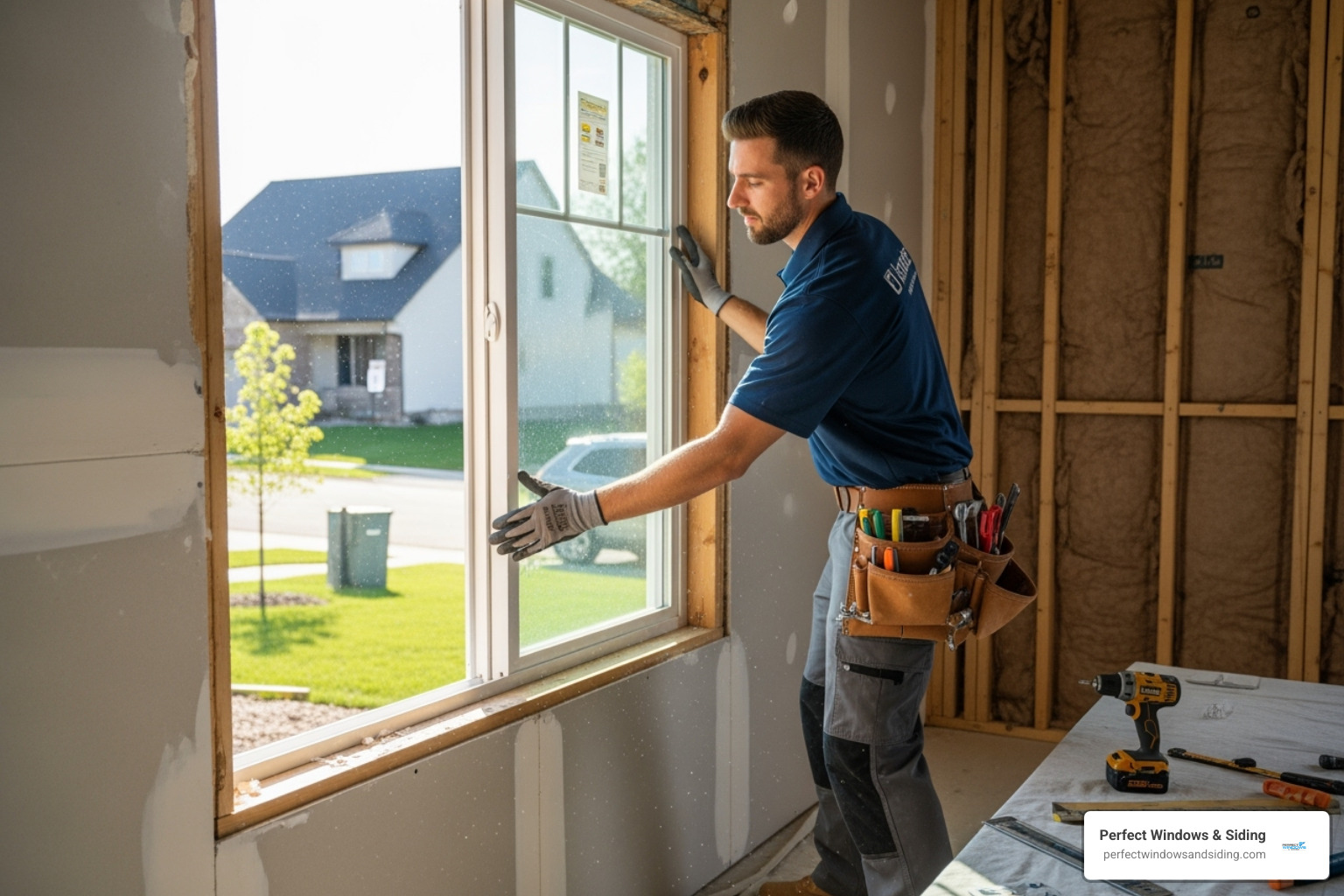
Labor is a significant part of the cost to replace a window. Professional installation ensures your windows perform correctly for decades.
Average labor costs range from $100 to $300 per window for a standard installation, with hourly rates around $30 to $65. This covers removal, installation, and sealing. Upper-story installations cost more due to the need for scaffolding or lifts.
Sometimes, removing an old window reveals structural issues like rotted wood or water damage. Repairing these problems can add $300 to $1,100 to the project but prevents more expensive issues later.
Creating new window openings is a major project involving cutting through walls and framing, which can add thousands to your cost.
While DIY seems tempting, improper installation can lead to leaks, mold, and structural damage, costing more to fix than professional installation. Our Window Installation Service Chicago is backed by a lifetime warranty, ensuring the job is done right.
How to Save on Your Window Replacement Project
There are several ways to reduce the cost to replace a window without sacrificing quality.
- Time your project strategically. Scheduling installation in the late fall or winter can lead to off-season discounts and faster scheduling.
- Replace multiple windows at once. This is more economical due to bulk material discounts and lower per-window labor costs.
- Choose standard window sizes. Custom sizes require special manufacturing, which adds cost and lead time. Sticking to standard dimensions saves money.
- Look for government incentives. Federal tax credits are often available for energy-efficient windows. We recommend you check for federal tax credits and we can help you find local Chicago-area programs.
- Get multiple quotes. Aim for at least three estimates from reputable contractors to understand market pricing. Be wary of bids that seem too good to be true.
- Prioritize smart upgrades. For the Chicago climate, double-pane windows with Low-E coatings and argon gas offer an excellent balance of performance and cost, providing most of the benefits of premium options at a lower price.
The Value Proposition: Why New Windows Are Worth the Cost
While the initial cost to replace a window can seem high, new windows are one of the smartest investments for your home. Old, inefficient windows can account for 25-30% of your home’s heat loss, costing you money daily.
Upgrading to energy-efficient windows provides numerous benefits:
- Energy Savings: A 10-15% decrease in energy costs, saving up to $583 per year.
- Increased Home Value: A high return on investment of 71-85%, boosting your home’s resale value.
- Improved Comfort: Eliminates drafts and cold spots, maintaining consistent indoor temperatures.
- Noise Reduction: Modern double or triple-pane windows significantly reduce outside noise.
- Improved Security: New windows feature better locking mechanisms and more durable frames.
- Better Curb Appeal: Instantly refreshes your home’s appearance.
| Feature | Old Single-Pane Windows | New Energy-Efficient Double-Pane Windows |
|---|---|---|
| Energy Efficiency | Very poor insulation, high heat loss/gain | Excellent insulation, significant energy savings |
| Comfort | Drafts, cold/hot spots, inconsistent indoor temperatures | Consistent indoor temperatures, no drafts, improved comfort |
| Noise Reduction | Minimal sound barrier, outside noise easily penetrates | Significant reduction in outside noise |
| Maintenance | Prone to rot, peeling paint, frequent repairs | Low maintenance, durable frames, long lifespan |
| Home Value | Can detract from value, lower appeal | Increases home value, boosts curb appeal, attractive to buyers |
| Security | Weaker locks, easier to break | Improved locking systems, more durable glass |
Telltale Signs You Need to Replace Your Windows
Your home will give you clear signals when it’s time to consider the cost to replace a window.
- Drafts: If you feel air moving around closed windows, you have leaks that are wasting energy. You can test for this by holding a lit candle near the frame; a flickering flame indicates a draft.
- Condensation between panes: Moisture or fog trapped between the glass means the seal has failed and the window’s insulating properties are gone. This cannot be repaired; replacement is the only solution.
- Visible damage or rot: Soft spots, cracks, or warped frames compromise your window’s structure and insulation. If you’re unsure if they can be saved, our Residential Window Repair Near Me service can help you assess the damage.
- Difficult to operate: Windows that are hard to open or are painted shut are a nuisance and a safety hazard. They should operate smoothly.
- High energy bills: If your HVAC system runs constantly but your home isn’t comfortable, inefficient windows are a likely culprit.
- Faded furniture: Old glass that doesn’t block UV rays can damage your carpets, furniture, and artwork. New windows with Low-E coatings prevent this.
Frequently Asked Questions about Window Replacement Costs
Here are answers to the most common questions we hear about the cost to replace a window.
Is it cheaper to replace all windows at once?
Yes, absolutely. Replacing all your windows in one project is more cost-effective. You benefit from bulk discounts on materials from the manufacturer. Labor costs per window are lower because fixed costs like transport and setup are spread across more units. You also get a consistent look throughout your home and only have to deal with the disruption of a single project. While spreading the cost over years might seem easier, it almost always costs more in the long run.
How long does it take to replace a window?
The timeline varies. A standard window replacement can take an experienced installer 30 to 60 minutes per window. More complex installations, like large picture windows or custom shapes, can take 4 to 8 hours each. A full bay or bow window might take one to two days.
A whole-house project of 10-15 windows is typically completed in 1 to 3 days. The entire process, from consultation to final installation, usually takes 2 to 4 weeks to allow for measurements and custom ordering.
Should I replace my 20-year-old windows?
In most cases, yes. Quality windows have a lifespan of 15 to 30 years. At 20 years, your windows are likely showing their age and costing you in comfort and energy bills.
Signs of aging like drafts, condensation between panes, or difficulty operating them become more common. The seals and frames degrade over time. Furthermore, window technology has improved dramatically in the last two decades. Modern ENERGY STAR-certified windows with features like Low-E coatings and argon gas are far more efficient than windows from the early 2000s. Upgrading is a smart financial move that improves your home’s comfort and value.
Get a Clear Price for Your Chicago Home
Now that you understand the factors that influence the cost to replace a window, you can make an informed decision. Every home is unique, so the only way to get an accurate price is with a professional, in-home consultation.
Working with experienced professionals who understand Chicago’s climate is the key to a great window investment. At Perfect Windows & Siding, we’ve served Chicago families for over 20 years. As a local, family-owned business, we’re your neighbors. We know which windows perform best in our harsh weather.
We provide custom solutions for your home, not a one-size-fits-all approach. We take the time to understand your priorities and budget. Most importantly, we back our work with a lifetime warranty, giving you decades of comfort and peace of mind.
Ready to see what new windows will cost for your home? Schedule your free consultation today! We’ll provide a precise, no-obligation quote with no pressure or surprises.

